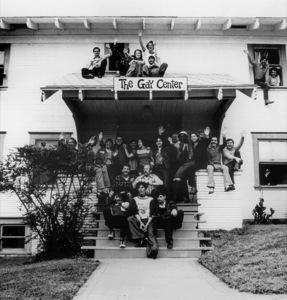
San Diego has a very vibrant past, especially in the LGBT community. The history is just as colorful – and fabulous – as its people. You don’t have to dust off an old book, however, to learn about America’s Finest City’s early days. Just look around and you will see several organizations and establishments that are living San Diego’s history today.
The Brass Rail
Then: The Brass Rail opened as a restaurant in 1958, on the corner of Sixth Avenue and B Street in downtown San Diego. Lou Arko, a straight Italian man, was the original owner, since LGBT business owners were not issued licenses to run bars and clubs at the time.
It had a lively happy hour where the downtown businessmen and their secretaries met up, according to the Hillcrest History Guild. “The evening crowd changed and more men came in to socialize around the piano bar,” the Guild’s Web site reads, “Then at night, the clientele became mostly gay men since this was one of the only places in town where they felt comfortable.”
Now: The Brass Rail moved from its downtown location to Hillcrest in 1963, first on the north west corner of Robinson and Fifth Avenue, the current location of Washington Mutual Bank. A decade later, it moved across the street to its present location at 3796 Fifth Ave. It is San Diego’s longest-running gay bar.
Dignity San Diego
Then: Dignity USA, a Catholic organization providing a safe and supportive faith community for LGBT Catholics, began in San Diego in 1969.
“When I started Dignity in 1969 in the eyes of the world it was probably a very small thing. However, in the microcosm of my own life, it was a monumental gamble,” said Dr. Patrick X. Nidorf, founder of Dignity USA.
Nidorf later moved the organization to Los Angeles and San Diego’s own chapter started in 1972.
Now: Dignity San Diego celebrated its 40th anniversary with a special mass July 22, during San Diego’s Pride weekend.
Dignity San Diego continues to meet every Sunday, 6 p.m. at Universalist Unitarian Church in Hillcrest.
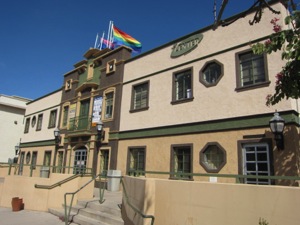
Metropolitan Community Church of San Diego
Then: San Diego’s Metropolitan Community Church (MCC) met for the first time in 1970, just two years after Rev. Troy Perry started the national organization in Huntington Park. Rev. “Papa” John Hose was San Diego’s first full-time pastor.
Now: MCC San Diego continues to meet each Sunday, 9 and 11 a.m. at their church home in Mission Bay.
The San Diego LGBT Community Center
Then: In 1971, San Diegan Jess Jessop laid the foundation for what was to become The Center by setting up an answering machine help line for anyone in the local LGBT community struggling with a more dangerous environment. A few years later, the Center for Social Services opened at 2250 B Street with a variety of programs designed to meet the unique concerns of the lesbian/gay community. It was the second of its kind in the nation.
From The Center’s Web site: “We are proud of the history of The Center’s service: From an answering machine in a borrowed closet that served as a lifeline for those frightened, lonely and looking for compassionate connection to today, the nation’s second oldest and third largest LGBT Community Center.”
Now: The Center, now located at 3909 Centre Street, celebrated its 39th anniversary just last weekend with its annual Gala.
“The incredible dedication of 800 volunteers, 20 board members and 40 staff who spend every day attempting to serve the full diversity of our community makes it possible for us to serve more than 46,000 clients each year.”
Imperial Court de San Diego
Then: A social and fundraising organization, the Royal Court de San Diego crowned its first monarchs, Empress Tawny Tann and Emperor Omar, in 1973 at the Royal Inn Convention Center (now the Holiday Inn at the Embarcadero). With more than 1,000 people in attendance, the first Imperial Coronation Ball was the first “homosexual event” ever held in a public hotel in San Diego.
Now: According to its Web site, the Court of San Diego has established itself as one of the most successful fundraising organizations in the country, raising hundreds of thousands of dollars for local charities. The Imperial Court has also played a major part in helping establish The LGBT Center, San Diego Pride, Stepping Stone, AIDS Walk and Mama’s Kitchen.
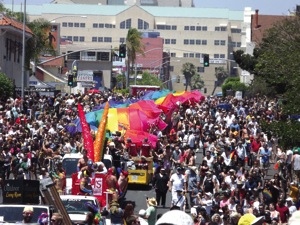
San Diego LGBT Pride
Then: In 1974, about 200 gays and lesbians marched through downtown San Diego to publicly proclaim their sexuality. Many of the marchers wore paper bags on their heads to protect their identity.
The next year, San Diego organized its official Pride parade march. Minnesota state Sen. Alan Spear, one of the first openly gay elected officials, and national lesbian activist Barbara Gittings rode in the parade and spoke at the rally.
Now: Held in July each year, San Diego’s Pride march is San Diego’s largest public event, drawing almost 200,000 spectators. The weekend event also includes a political rally and two-day festival in Balboa Park.
In addition to the weekend festivities, Pride also organizes community outreaches, voter registration drives, holiday toy and food drives, a block party, leadership development and youth development projects, and other projects throughout the year.
This year, Pride has also launched the Stonewall 40 history project to record and preserve the San Diego events as well as similar events across the country.
America’s Finest City Softball League
Then: Founded in 1981 by a group of informal softball players, the San Diego Gay Softball League started off as little more than people gathering at a field just off the banks of the San Diego River in Mission Valley to play exhibition games.
Now: The America’s Finest City Softball League (AFCSL), as it is currently called, is one of the largest sports organizations in San Diego. Its spring season boasts more than 30 teams, and more than 500 active participants. The league also hosts a smaller, more relaxed fall season.
“Our league has provided a safe space for the LGBT community to gather and socialize and play softball in a warm and welcoming environment,” Brian Burnett told the LGBT Weekly in 2011, at the start of its 30th season. “We’ve been that place where men and women have first come out and embraced who they are, where new residents meet their new San Diego families’ and become involved in the community.”
A few weeks ago, AFCSL hosted the 29th annual Autumn Classic with LGBT softball teams from around the country. The Autumn Classic is considered the third largest annual LGBT sporting event in the world.
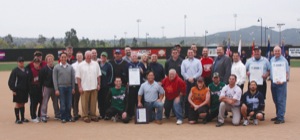
Front Runners
Then: Front Runners, a running and walking club for the LGBT community, was founded in 1981 by Carol Pierce and Jeff Wynne. They were joined by six others on the corner of Sixth Avenue and Laurel for their first run.
Now: Under the full name Front Runners and Walkers San Diego, the group boasts more than 200 members, ranging from athletes in their 20s to their 70s. The group meets at the same corner in Balboa Park three times a week for running and walking.
In 1974, the Teddy Roosevelt Republican Club of San Diego was founded. The club did not last long, and the Log Cabin Republican Club was formed in 1981. Today’s group has been recognized with the national Wil Drabenstot Memorial Award for Chapter Excellence.
In 1970, the Women’s Studies Dept. was founded at San Diego State University. It is considered to be the first department of its kind in U.S. academia.
In 1975, the San Diego Democratic Club was founded. The club changed its name last year to the San Diego Democrats for Equality. This past September, the political club sent 10 delegates to the Democratic National Convention in Charlotte, N.C., the largest number of delegates the club has ever sent to the convention since its founding.
In 1976, Stepping Stone was founded, a residential recovery program for gay alcoholics in San Diego. Today, “Stepping Stone operates both a residential and a non-residential recovery program, each based upon evidence-based best practices of recovery, to meet the different needs of our clients.”
In May of 1979, the Greater San Diego Business Association (GSDBA) was started with just 21 members. In August of that same year, the GSDBA published its first business directory; it was 16 pages with 67 businesses. Today, the group boasts more than 800 businesses and professionals, making it the second largest LGBT chamber of commerce in the United States.
The local chapter of Parents and Friends of Lesbians and Gays (PFLAG) met for the first time in December 1982. PFLAG now represents more than 75,000 households, and speaks for thousands of others.
In 1985, the San Diego Men’s Chorus gathered. Their first performance was the following year. That same year, in 1986, the San Diego Women’s Chorus was founded. Today, the two groups still perform.
In 1986, the first production at the Diversionary Theatre was performed. The mission of the Theatre is to produce plays with LGBT themes that portray characters in their complexity and diversity both historically and contemporarily. It’s current show, Pippin, opens its 2012-2013 season. It is the third oldest continuously producing LGBT theater in the United States.
In 1997, the first planning meeting of the Lesbian and Gay Archives took place. The Archives started with a collection of historic materials from Jess Jessop and Doug Moore. The organization has since changed its name to the Lambda Archives. It moved into a permanent location at 4545 Park Blvd. this year. It is one of the largest collections of LGBT history in the country.
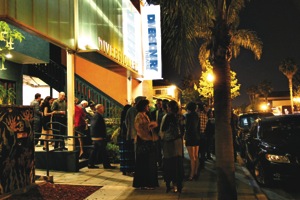
Editor’s Note:
This list is not comprehensive, by any means. If you are interested in learning more about San Diego’s LGBT history, we encourage you to check out the Lambda Archives (lambdaarchives.us), the Hillcrest History Guild (hillcrest history.org) and the national LGBT History Month (lgbthistorymonth.com)












Hi I was wondering if you had an idea of gay bars in hillcrest in the 70’s ? There was a Disco on the corner of University and fifth for a bit need a name. And does anyone remember the club Jerry’s Hole that used to be around 1973? Any info would be helpful. Thanks San Diego native now in LA
Hi I remember the name Jerry’s Hole but I think the name was changed and now can’t remember . I am trying to find out about The Barbery Coast on PCH spent many a night in there dancing. Would like to start a blog and get people to re-connect .
I believe the place on 5th and University you’re asking about was a bar called Basin Street. You had to be 18 to get in, and if you were 21 or older, you’d get a wrist band so that you could order beer. And of course, I remember Jerry’s Hole. It was on San Diego Ave. near Washington Street. It was across the street from where Leo Hamel’s is now. I think it’s a transmission shop today. Back then it had a fire ring outside and Chris was the usual bartender. It was another “Chicken Bar”, meaning you didn’t have to be 21 to get in. Elton John used to go there after each concert he played in San Diego in the late 70’s. A lot of the kids would go downtown where they could get a fake I.D. made for a couple bucks on Broadway so that they could get into The Barbary Coast, On Pacific Highway and Laurel St. The only problem with that place was that each weekend, at some point, Vice Squad would show up. They’d turn up the lights, and they’d I.D. a few people, looking for minor’s. Then they’d pick someone out, take them around back and beat the crap out of the them. Of course, if you went to complain to the police in those days, they’d laugh at you, and do it again. No one ever dreamed the day would come when there would be openly gay cops, much less the day coming when same sex couples could get married. You just took your chances, and put yourself at huge risk in those days, just to go out and dance. The LGBT community has come a long….long way, and the people back then endured a lot of hate and abuse so that people could enjoy the freedom they have today.
Went to the Barbery Coast many times and never had the experience of the Vice Sqaud, I would have freaked. Never aware that they beat peopleI never would have gone back.